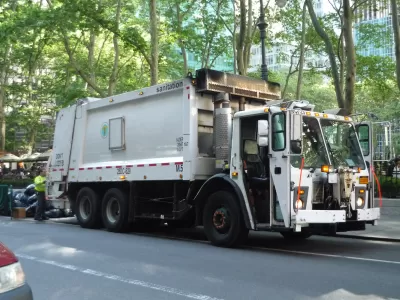The city had ambitious goals to reduce waste, but millions of tons of garbage are still sent to communities around the country each year.

As part of a series on New York City’s management of refuse, Sally Goldenberg and Danielle Muoio explore the city’s failed efforts to develop effective recycling and waste reduction programs.
In 2015, Mayor Bill de Blasio outlined a plan to drastically cut down the city’s waste. "The goal was to slash the 3.6 million tons of garbage the city shipped out in 2005 by 90 percent, so that by 2030 the five boroughs would export only a collective 360,000 tons of waste," say Goldenberg and Muoio.
But New York City continues to send huge amounts of waste to landfills and incinerators in communities across the country. In the past fiscal year, the city exported 3.25 million tons of residential waste, and recycling rates are low across the board.
The city depends on these facilities, especially after the closing of Fresh Kills, the Staten Island garbage dump. But residents in communities receiving New York City’s waste say they are suffering the public health and environmental consequences.
"Nearly two decades since Fresh Kills closed, there’s little indication the city is going to end its reliance on out-of-state landfills anytime soon. One former Bloomberg official warned that strategy is unsustainable," note Goldenberg and Muoio.
FULL STORY: Wasted Potential: The consequences of New York City's recycling failure

Alabama: Trump Terminates Settlements for Black Communities Harmed By Raw Sewage
Trump deemed the landmark civil rights agreement “illegal DEI and environmental justice policy.”

Study: Maui’s Plan to Convert Vacation Rentals to Long-Term Housing Could Cause Nearly $1 Billion Economic Loss
The plan would reduce visitor accommodation by 25% resulting in 1,900 jobs lost.

Planetizen Federal Action Tracker
A weekly monitor of how Trump’s orders and actions are impacting planners and planning in America.

Wind Energy on the Rise Despite Federal Policy Reversal
The Trump administration is revoking federal support for renewable energy, but demand for new projects continues unabated.

Passengers Flock to Caltrain After Electrification
The new electric trains are running faster and more reliably, leading to strong ridership growth on the Bay Area rail system.

Texas Churches Rally Behind ‘Yes in God’s Back Yard’ Legislation
Religious leaders want the state to reduce zoning regulations to streamline leasing church-owned land to housing developers.
Urban Design for Planners 1: Software Tools
This six-course series explores essential urban design concepts using open source software and equips planners with the tools they need to participate fully in the urban design process.
Planning for Universal Design
Learn the tools for implementing Universal Design in planning regulations.
Caltrans
Smith Gee Studio
Institute for Housing and Urban Development Studies (IHS)
City of Grandview
Harvard GSD Executive Education
Toledo-Lucas County Plan Commissions
Salt Lake City
NYU Wagner Graduate School of Public Service





























